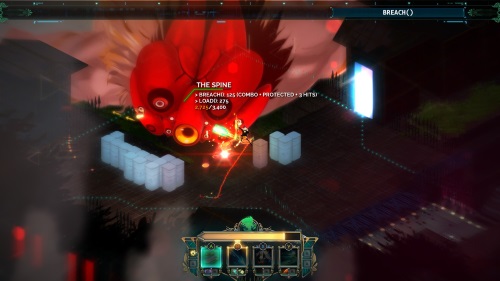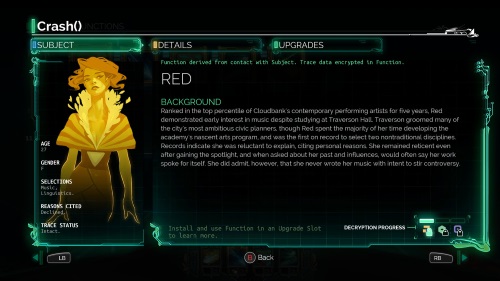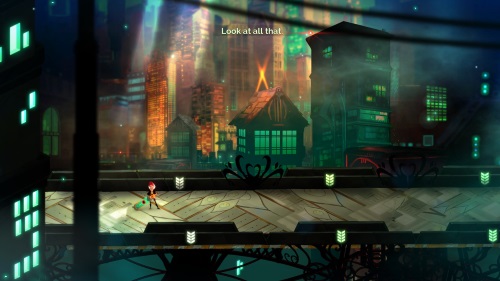Despite hearing lots of praise for it, I’d skipped out on Bastion, thinking that it looked too lightweight. Supergiant’s follow-up, Transistor, was an even bigger success. It has a cool female protagonist, an awesome, nigh infinitely-configurable weapon and an original science-fiction world.
I have to admit that I didn’t like it at first. Most of the character’s, Red, animations are rather slow and contributed to the controls feeling clunky. I didn’t know what the setup for this world is and I kept dying. I was also expecting this to be a nonstop combat game with enemies scattered across the whole level, like in a Diablo game. Instead, this game is structured around fixed encounters. You enter an area, enemies spawn and you’re not allowed to leave until you’ve killed all of them. This reinforces the impression of this being a series of rooms instead of a big, open world.
But as I gained access to more powers, called functions here, and started using the turn-based mode more, called turn(), everything started to click for me. It took getting into the break room and playing around with the challenges for me to realize that you really should be using turn() almost all of the time. After that, the game actually got really easy. By the end of the game when you fight the Man-type enemies, it’s almost a joke since Void() and Cull() kills one of them in a single turn() before they can spawn anything.
As expected, most of the fun here is experimenting with the insane number of combinations of functions. There are sixteen of them, and each of can be used in one of three slots: an active slot, which you invoke directly as a power, an upgrade slot to modify the effects of another active function, and a passive slot, which is self-explanatory. Experience points unlock levels, which in turn unlocks stuff like memory capacity, upgrade slots and passive slots. Memory limits how many different functions you can use at any one time.
The available functions can do all sorts of stuff, like the short-ranged Crash() which does some damage and stuns enemies, Void() which increases subsequent damage on affected enemies, Mask() which makes you invisible, Help() which summons a minion and so forth. There’s some nice of variety of enemies and since I ended up using the turn() so much, the most annoying enemy to me ended up being the lowly Snapshot drone. They have low health and low damage, but they project some kind of field which blanks them out in turn() and kicks you out into real-time mode if you run into it. Neat.
I’m not a big fan of the story. There’s a lot of backstory written in the datafiles I know but the game doesn’t do a good job of getting across what’s going on directly during gameplay or why you should care. Telling large part of the story through the OVC Terminals is cool, but perhaps a bit too subtle. The voice acting in this game pretty bad I think, since they convey no emotion at all. I do like the world. I’m convinced that they all live in a virtual world in the first place and that the Process is just another huge program from a different virtual world and the interior of the Transistor is a virtual world inside a virtual world. I’m also ticked that talking weapons have been a fantasy trope since at least Stormbringer but this is arguably the best example of it in gaming.
The game does seem a little short given that the gameplay here is so rich that there should be more content to support it. Still, I guess the New Game+ mode, naturally called recursion here, is better than most. Apparently there are a whole series of challenges that only available in this mode. I also notice that there seems to be some small changes in the story. I’ll have to delve deeper into this when I have the time. So overall, a very impressive and fun small game.


